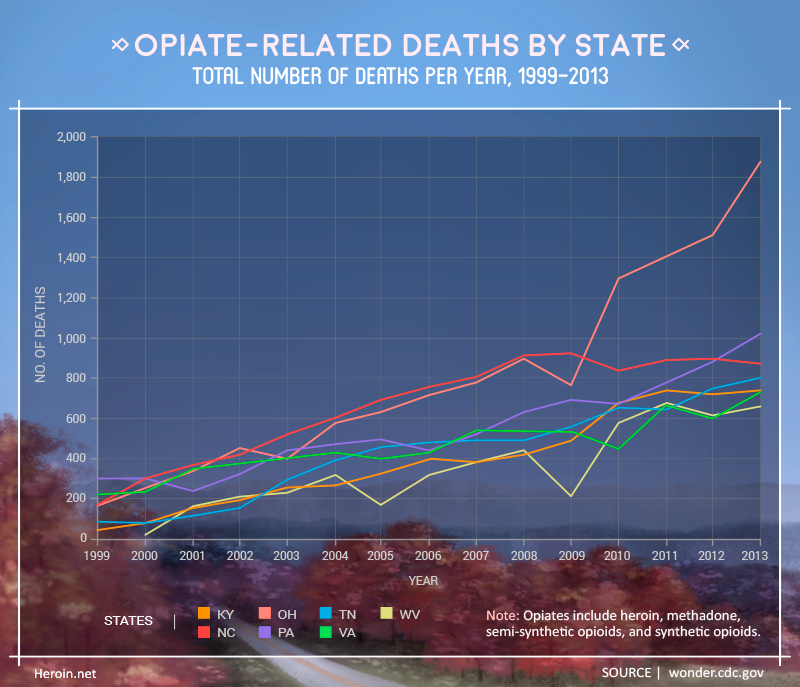
FILE — Larry Gibson, whose family has owned land in the area for 235 years, stands atop Kayford Mountain in West Virginia. (AP Photo)
There’s a disturbing trend in Appalachian country, a distinctive region in the eastern United States, perhaps best known for its mountain people and struggling coal mining industry. The seven Appalachian states account for more than a fifth of the of the country’s opiate-related deaths since 1999.
Opioids are prescription pain relievers — such as OxyContin, methadone, hydrocodone, codeine, morphine — and heroin.
The Appalachian states include Kentucky, North Carolina, Ohio, Pennsylvania, Tennessee, Virginia and West Virginia. While these states have thriving urban and suburban communities, an Appalachian culture associated with people living close to the land, often associated with coal-mining communities, continues to persist along the Appalachian mountains.
 Drug overdose deaths are a nationwide problem. The death rate from drug overdoses has increased 137 percent since 2000. In 2014, more people died from drug overdoses in the United States than any other year on record, according the the Centers for Disease Control and Prevention.
Drug overdose deaths are a nationwide problem. The death rate from drug overdoses has increased 137 percent since 2000. In 2014, more people died from drug overdoses in the United States than any other year on record, according the the Centers for Disease Control and Prevention.
Drug overdoses killed 47,055 people in 2014, and 61 percent of those deaths were opiate-related. The Appalachian region was especially hard hit. The seven states accounted for 22 percent of all opiate-related deaths.
The authors of a new report on the rising epidemic in Appalachia say poverty and a lack of higher education could be a factor.
According to the report, “the hardest-hit counties, where death rates have soared…have about half the national median household income while twice as many people live below the poverty level. College educations are dramatically lower than the national average in the most affected counties, and in a room full of 100 people about 40 won’t possess even a high school level education.”
“It’s pretty obvious that when you have a higher education level throughout a lot of these areas, that there’s more access to resources like places to go if you need help, drug resistance education, and things along those lines,” said Tristan Harris, project manager for the report from Heroin.net. “Whereas, in an area where a much lower percentage of people are graduating from high school, much less from college, they [might not] have access to those kinds of programs or those resources.”
States’ attempts to crack down on prescription drug abuse over the past few years seem to be driving the move from prescription drugs to heroin.
“That’s the trend that’s been happening for the last few years,” Harris said. “It could be an issue with legislation coming across to help stem the over-prescribing of opioids, and it could be that people that have become addicted to those are turning to heroin when that supply is no longer available.”
North Carolina has managed to stem the tide. The state initiated a plan to combat opiated-related deaths in one of its hardest hit counties in 2008. By changing the way clinical professionals and residents were educated about and treated for opioid addiction, North Carolina was eventually able to reduce overall drug overdose deaths statewide.






















There’s a reason why painkillers are called ‘hillbilly heroin’. I’ve no doubt the author has heard the term, but opted against using it.
When people feel that life is bleak and depressing, drugs appeal as a vacation of sorts. In this case, state regulations have clamped down on access to painkillers, driving up prices. Then, an addict finds a related, cheaper, more available substitute and switches over. Heroin is creeping in to middle class life, but will always be around, arm-in-arm with poverty.
If opiate drugs were distributed differently by doctors and the pharmaceutical companies that manufacture them, thousands of young lives could be saved. As an example: if a doctor prescribed prescribed opiates for a wrenched shoulder, they would determine how many pain killers it would take for the injury to heal.
Now doctors are able to give 60 painkillers for a small injury. That large amount must be lowered. Equally, if they were to distribute them only to the parents in small amounts (ten pills or less, in two or three visits, and only with the consent of the parents being told exactly how the drug contributes to the rise of heroin abuse). Opiate drugs are basically of the same construction as heroin, and heroin is far cheaper in the U.S. When the young person is hooked on the drug, a buddy may help him by saying, ‘Hey, I can get you a better high.’ And once you’re on heroin, you’re hooked,
If the lesser amounts and the mandatory screening by parents of young people acquiring pain killers could be prescribed by Congress-or done without the help of Congress-then the hue and cry should be all over the country to get this done.
I agree with Brian. We need Legislators that will help end this crisis. This is a physician prescribed epidemic. Law Enforcement is the only agency trying to put a stop to this. Doctors are being charged with first degree murder. Removal of a high prescribers license would be kinder. Too much money and greed. More value should be placed on a human life.
THERE ARE NO JOBS – TRUE UNEMPLOYMENT IN THE REGION IS WELL OVER 30%
THERE ARE NO WAY TO SUPPORT YOUR SELF FINANCIALLY…
MANDATORY HEALTH CARE INSURANCE LAWS DO NOT SOLVE A PROBLEM
THE PROBLEM IS NOT HAVING A JOB.THAT ALLOWS YOU TO SUPPORT YOURSELF
Its not some mystery epidemic and its not directly related to education levels..
In major cities where a much larger portion of people of people have at least a bachelor degree, and can only get a 10 dollar and hour job despite that degree, you still have booming drug abuse and escapism.. Its just he drugs of choice change across racial and regional populations.
Crack – Black
Meth – Rural Whites
Powder Cocaine – NYC urbanites with some family money
Prescription Pills from the local clinic – S/E whites
No mystery here. You are importing tens of millions of foreign nationals into the USA each decade, ax-murdering the labor market and wages, and in previous generations, rural americans – black and white – moved to the urban regions to find work and support themselves, which is no longer possible because those places are now 3rd world hellholes over filled with all the cheap 3rd world labor that the folks bribing off our crooked political class are using the destroy wage standards down to 3rd world levels.
EVEN WITH A COLLEGE DEGREE, most cannot find a job in their chosen field that they can live on, so suggesting that some post-H.S. educational degree is the ‘answer’ is nonsensical on its face – those who are being left behind and betrayed by the elites who rigged the system and sought out slave labor will in a lot of cases self-medicate, and destroy themselves.
We have a crooked nation run by speculators and paid-off servants of global slave labor interests, and are no longer a nation in the true sense, only a ‘place’.